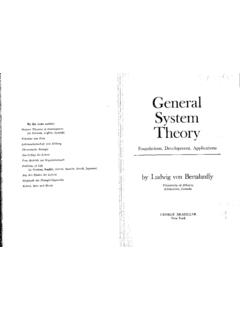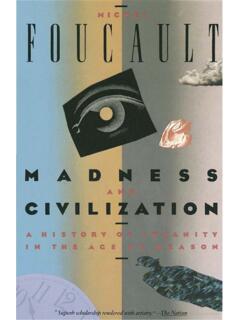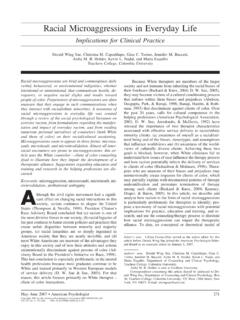Transcription of THE PRESENTATION OF SELF
1 THE PRESENTATION OF SELF1 INEVERYDAY LIFEERVING GOFFMANU niversity of Edinburgh Social Sciences Research CentrePrice : Ten ShillingsTHE PRESENTATION OF SELFINEVERYDAY LIFEERVING GOFFMANU niversity of Edinburgh Social Sciences Research Centre $9 George Square, Edinburgh SMonograph No. 21956oMasks are arrested expressions and admirable echoes of feeling, at once faithful, discreet, and superlative. living things in contact with the air must acquire a cuticle, and it is not urged against cuticles that they are not hearts; yet some philosophers seem to be angry with images for not being things, and with words for not being feelings.
2 Words and images are like shells, no less integral parts of nature than are the sub stances they cover, but better addressed to the eye and more open to observation. I would not say that substance exists for the sake of appearance, or faces for the sake of masks, or the passions for the sake of poetry and virtue. Nothing arises in nature for the sake of anything else; all these phases and products are involved equally in the round of ex isten Santayana 11 S o li l o q u i e s in E n g la n d a n d L a te r S o l i l o q u i e s (New York: Scribners, 1922), pp.
3 LEDGEMENTSThe report presented here was developed in connection with a study of interaction undertaken for the Department of Social Anthropology and the Social Sciences Research Committee of the University of Edinburgh and a study of social stratification supported by a Ford Foundation grant directed by Professor E. A. Shils at the University of Chicago. I am grateful to these sources of guidance and support. I would like to express thanks to my teachers C. W. , W. L. Warner, and E. C. Hughes. [ want, too, to thank Elizabeth Bott, Jam es Littlejohn, and Edward Banfield, who helped me at the beginning of the study, and fellow-students of occupations at the University of Chicago who helped me later.]
4 Without the collaboration of my wife, Angelica S. Goffman, this report would not have been R E F A C E1 mean this report to serve as a sort of handbook detailing one sociological perspective from which social life can be studied, especially the kind of social life thar is organised within the physical confines of a building or plant. A set of features will be described which together form a framework that can be applied to any concrete social establishment, be it domestic, industrial, or perspective employed in this report is that of the theat rical performance ; the principles derived are dramaturgical ones.
5 I shall consider the way in which the individual in ordin ary work situations presents himself and his activity to others, the ways in which he guides and controls the impression they form of him, and the kinds of things he may and may not do while sustaining his performance before them. In using this model I will attempt not to make light of its obvious inadequa cies. The stage presents things that are make-believe ; presum ably life presents things that are real and sometimes not well rehearsed. More important, perhaps, on the stage one player resents himself in the guise of a cha^.
6 Cter to characters pro jected by other players; the audience constitutes a third party to the interaction one that is essential and yet, if the stage performance were real, one that would not be there. In real life, the three parties are compressed into two; the part one indi vidual plays is tailored to the parts played by the others pre sent, and yet these others also constitute the audience. Still other inadequacies in this model will be considered illustrative materials used in this study are of mixed status: some are taken from respectable researches where qual ified generalisations are given concerning reliably recorded regularities; some are taken from informal memoirs written by colourful people; many fall in between.
7 The justification for this approach (as I take to be the justification for Simmei s also) is that the illustrations together fit into a coherent frame work that ties together bits of experience the reader has already had and provides the student with a guide worth testing in case- studies of institutional social framework is presented in logical steps. The intro duction is necessarilv abstract and may be A B L E O F C O N T E K T SPA G EAcknowledgementsPreface'NTRODUCTION .. 1CH PERFORMANCES .. 10II TEAMS .. 47ill REGIONS AND REGION BEHAVIOUR.
8 66iV DISCREPANT ROLES .. 87V COMMUNICATION OUT OF CHARACTER .. 107VI THE ARTS OF IMPRESSION MANAGEMENT .. 132 VII CONCLUSION .. 152 INTRODUCTIONWhen an individual enters the presence of others, they commonly seek to acquire information about him or to bring into play information about him already possessed. They will be interested in his general socio-economic status, his conception of self, his attitude toward them, his competence, his trust worthiness, etc. Although some of this information seems to be sought almost as an end in itself, there are usually quite prac tical reasons for acquiring it.
9 Information about the individual helps to define the situation, enabling others to know in ad vance what he will expect of them and what they may expect of him. Informed in these ways, the others will know how best to act in order to call forth a desired response from those present, many sources of information become accessible and many carriers (or ' sign-vehicles ) become avail able for conveying this information. If unacquainted with the individual, observers can glean clues from his conduct and appearance which allow them to apply their previous experience with individuals roughly similar to the one before them or, more important, to apply untested stereotypes to him.
10 They can also assume from past experience that only individuals of a partic ular kind are likely to be found in a given social setting. They can rely on what the individual says about himself or on doc umentary evidence he provides as to who and what he is. If ttiey know, or know of, the individual by virtue of experience prior to the interaction, they can rely on assumptions as to the persistence and generality of psychological traits as a means of predicting his present and future , during the period in which the individual is in the immediate presence of the others, few events may occur which directly provide the others with the conclusive infonnation they will need if they are to direct wisely their own activity.














